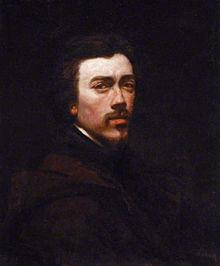I’m working on a commissioned portrait at the moment that is
proving tricky. The sitter is dressed in a black suit and Masonic regalia. This
is to be a formal and traditional portrait, so I’ve been looking at hundreds of
the things for ideas, and have decided I definitely want a dark background. I’ve
reached the stage where I’ve done all the under-painting and have had some
success in that it certainly looks like the sitter, the pose is good, and the
regalia is taking shape. The problem is the black suit. The colour I’ve chosen
for the background is a very dark green, and whilst in daylight you can see the
change from black to green, by electric light the distinction disappears
completely. I’ve tried lightening the background a little by adding a yellow
glaze, but that still gets swallowed up in electric light and is in danger of
looking garish in daylight. The suit itself is matt black, so I can’t use the
tricks I might use if it were black satin with all the light reflections. I
haven’t fallen into the trap of using black paint at least, though I’ve come
perilously close with a bit of Payne’s Grey, a colour I rarely use.
To try to sort this problem out, I took myself yesterday to
the Bowes Museum,
which is the nearest art gallery to my location likely to contain portraits
that might help. There are formal
paintings closer to home – Bishop Auckland Castle has plenty of paintings of
past Bishops – but the problem there is the really good portraits look in
desperate need of a clean so it’s hard to see what the artists did to solve the
problem, and the more modern ones that don’t need cleaning tend to have light
backgrounds, which is not the effect I’m after.
There are some fantastic portraits in the Bowes. My favourite
is an 1874 self portrait by French realist François Bonvin. He’s wearing very dark clothes – so dark you can barely
make out whether it’s an overcoat or monk’s habit or what – has dark hair, and
has painted himself against a very dark background. This means you see the face
and only the face because the rest virtually merges together. This ought to
matter, but in this particular painting it absolutely doesn’t, so it shows
beyond a shadow of a doubt that in certain circumstances a background/clothing
merge can be made to work. It still makes me nervous of attempting such a
thing. I am no Bonvin.
Another painting
that does something similar, though has more light in it generally is a
fabulous portrait of Lord Harry Vane by George Frederick Watts. Unfortunately I
can’t find that one on the internet so can’t show it. He is wearing a dark suit
and one of his shoulders almost merges into the background, but he has a shock
of white hair and there is other brightness in the picture (a medal, his white
shirt) so there’s more of a sense of balance, if less drama, than the Bonvin.
The suit itself, though clearly black, is painted in shades of grey, but where
it meets the background there is still virtually no distinction. It works
because the viewer knows where his shoulder must be, so sees it anyway. It’s
not a trick of the eye so much as the use of logic and seeing what you know
must be there.
The Bowes is also
currently hosting a selection of photographs by Robert Mapplethorpe, and some
of these do exactly the same thing – the tonal difference between a shoulder in
a dark shirt and a dark background can be incredibly slight, but the eye still
sees it and knows exactly what it’s seeing.
So maybe the answer
is not so much in the tonal values as in the draftsmanship. If the suit is well
enough painted and clearly shows how the fabric forms around the body
underneath, then a major distinction in tonal values is not required. The
viewer’s brain will work it out. This puts the onus on me as the artist to get
the suit right. I must stop worrying so much about the distinction between the
edge of the suit and the dark of the background and work more on suggesting
that there really is a solid body underneath that thick black fabric. If I can
do that, the rest will take care of itself.
That’s the theory,
anyway. The next few months of painting will see whether I can pull it off.
There is no hurry for this one to be finished, luckily, so I have the luxury of
working in oils rather than acrylics and being able to let glazes dry completely
– also I have ready access to the sitter whenever required, so I don’t have to
rely on guesswork.
The next problem
will be the regalia. The trick there is going to be how to suggest or the
detail without actually painting it in, because I’m no miniaturist so am
absolutely not going to start working in a brush with one squirrel hair. The
trick here is to see how the light catches the braid, and for that there are
plenty of artists to show me the way from Gainsborough to Manet – but that’s a
problem for another day.

No comments:
Post a Comment